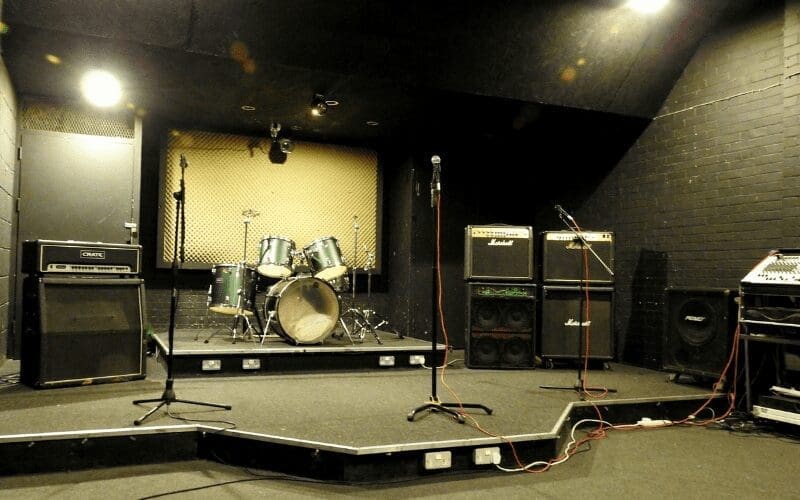Welcome to the ultimate guide on how to have a successful band rehearsal both in-person and remotely! It is aimed both at beginners and professional musicians. We have added examples that scale up or down the timelines based on different rehearsal experiences. Throughout this article, we will be exploring the best band rehearsal strategies, how to prepare, how to set goals, and more!

Remember that each situation is unique and each situation can require different band rehearsal strategies. For example, you may be leading a class, rehearsing a trio, or a rock band. Don’t be scared to experiment in order to find what works best for you while using some of the guidelines below. Let’s jump in!
Why Are Band Rehearsals Beneficial?

As stated above, this article will answer some recurrent questions. The first important one is, of course, “Why are band rehearsals beneficial?
When getting a concert together, you can hire some really good musicians who will play well and go home without a sweat. However, sometimes that’s not always the case.
Rehearsals can really make or break a performance and band rehearsal strategies are super important. Rehearsing, especially with professional musicians, is not so much about playing the songs in their most basic fashion, but about the details. Such as the creation of links between songs, alternative endings, and “moments”.
The reason why the bands you love the most are so captivating when playing live is because they create moments with the audience. Or even interactions between themselves. Physically, but also musically.
In order to study some of these concepts of “moments”, you may want to focus on some of the greats like Bram Bessoff from indiehitmaker.
Anyway! To help get this guide started, we’re going to go over the best band rehearsal space and room setups. Let’s talk about it!
Band Rehearsal Space

One common mistake we make when we rehearse is to try to set up in a “live show” formation. Meaning we try and set up as if we were presenting the material to the walls.
It’s important to understand that the best possible band rehearsal room setup is to have open communication between the instrumentalists and vocalists.
A circle shape is going to be the best rehearsal format. Of course, when doing a dress rehearsal you may want to re-create the “live show” set up. You also want to make sure everybody can hear themselves by setting up monitors and amplifiers so you get a good general balance.
Usually, the amplifiers will give good results if located behind each instrumentalist. Monitors should be in front of the singers and some general “side fill” for the other instrumentalists will help.
In an ideal world, each person who sings would get their own monitor or headphone mix. With in-ear monitor prices being very low and the technology to run rehearsals on in-ears, chances are you will be able to have personal headphone mixes for each musician. This will allow for the best possible rehearsal monitoring.
Band Rehearsal Preparation

Preparation material can be different for each ensemble, style, and musicianship level.
In bands with readers, you may want to send sheet music to each musician, either a lead sheet or parts for each instrument when available. When using sheet music, dynamics is one of the only elements left to work on.
In bands in which some read and others do not, you’ll use a combination between sheet music and ear learning. Remember that the sheet music should be as close as possible to the original song.
When preparing a rehearsal, you need to think about your setlist and the focus of the rehearsal.
Ideally you would send the material to all of the members with more than enough time to prepare.
The context will dictate how much time ahead that is. For example, if you’re working with a professional level band, you may only need to send in the material 24h ahead of the rehearsal, or 3-4 days ahead for an entire set list of material (20-30 songs).
On the other hand, if you’re working with a high school band, you may need to give the rehearsal material to the musicians a week ahead for 1 or 2 songs. It is important to set realistic goals for your rehearsals, if not, the process will be frustrating and you’ll feel like everything went wrong.
Setting Goals

There are many different band rehearsal strategies but one of the most important elements of rehearsing is setting goals.
When you communicate your expectations and the things that should be accomplished before the end of the rehearsal, you will end up achieving your desired goals much faster.
Below are some examples of different situations and band rehearsal strategies to give you some guidance. The second example includes a band rehearsal plan template to help you structure your rehearsal, stay tuned!
Example 1
I have 2 rehearsals to get a 25-song show ready with Band X. The band is made of professional musicians who will learn the repertoire via audio and charts.
Two weeks before, I would send the rehearsal packages. This package includes sheet music and audio for the songs. Try to avoid using YouTube links. Instead, send mp3 or m4a files to your musicians. Every musician will have the same audio version and you’ll save time in rehearsal.
With the rehearsal material, you should include what you want to accomplish in the rehearsals before this show. Your plan may be to use each rehearsal as 2 different parts, dividing the setlist into 2 sets.
You may also, depending on the length of the rehearsals, want to run through everything twice. In this format, you’d have a 4h rehearsal to go through each song and add some modifications to the arrangement.
You would also have a 2h rehearsal to run the show through once in case you missed something (guitar changes, exhausting set for your singer because of the song order, etc).
Example 2
I have 10 rehearsals over 5 weeks (1x 3 or 4h rehearsal a week) to get a 25-song show ready with Band X.
The band is made of amateurs or semi-professional musicians who will learn the repertoire via audio.
Two weeks before the rehearsal, I would send the rehearsal packages. This package includes audio for the songs, the potential setlist, and a detailed rehearsal plan.
Here is a band rehearsal plan template that you can use to help structure your rehearsals:
Band Rehearsal Plan Template
Week 1:
Rehearsal 1: Learn songs 1 to 7 (from set list)
Rehearsal 2: Review songs 1 to 7 in set order
Week 2:
Rehearsal 1: Learn songs 8 to 15 (from set list)
Rehearsal 2: Review songs 1 to 15 in set order
Week 3:
Rehearsal 1: Learn songs 16 to 22 (from set list)
Rehearsal 2: Review songs 1 to 22 in set order
Week 4:
Rehearsal 1: Learn songs 23 to 25 and practice songs 8 to 25 in set format (from setlist)
Rehearsal 2: Review songs 1 to 25
Week 5:
Rehearsal 1: Review songs that need some work. Then rehearse set
Rehearsal 2: Play the show once (dressed rehearsal)
Remember to be flexible. The plan only offers you a good idea of the pace of the ensemble and allows you to add rehearsals as needed. Its main function is to allow everybody to prepare the same material for the same rehearsal. If not, each member of the band may prepare a different set of songs, which will slow down the rehearsal.
A common mistake is to rehearse material and then forget about it. The material you rehearsed 3 weeks ago may not still be performance ready. Depending on the level of the ensemble or the amount of material you are working on, of course.
That’s why you want to run through all the material over again. This way you’ll get a strong and cohesive performance.
Be The Band Leader

An element that is very important in any group is a bandleader or rehearsal leader. This doesn’t need to be a static position, however.
If you have a band and there is no established bandleader or “owner” and you’ve established a 4 or 5-way equal share of the ensemble, you may want to have a rotation on who runs the rehearsals.
With that said, if you are the bandleader, these are your tasks:
- Making sure the set up will lead to a quality rehearsal
- Knowing the repertoire very well (form, intro length, etc)
- Knowing the order in which you want to practice the songs
- Understanding that not everything will go as planned
- Keeping an easy song at the start and end of the rehearsal to begin and finish on a good note (you can start with a song with the excuse of wanting to soundcheck the band)
- Record the rehearsal (can be on your phone or with an SD card audio recorder) eg. (zoom h2, zoom h4, etc), listen to the rehearsal, and take notes
- Choose rehearsal rooms, make arrangement, etc (when applicable)
Remote Band Rehearsal

Online band rehearsals can seem virtually impossible. You can certainly not use Skype or Facetime because of the latency.
There are a few band rehearsal apps, like Jam Kazam, JamLink, Jammr, and Ninjam that can be used to attempt jamming online. The services may be free, but usually, there will be a router-like box that you’ll need to purchase and set up.
Unfortunately, it has its limitations. The main hurdle is that all of them will have a lag. You’ll usually get some much better results if jamming locally or within the same internet server (within your city, state, or province). You should avoid using WiFi and, instead, be connected directly to your router via an Ethernet cable.
Also, you may need to change some internet settings to allow your connection to have as little latency as possible. You’ll also want to limit the number of musicians attending the rehearsal in order to make it as simple as possible.
Once you’ve achieved low latency, you’ll need to curate your repertoire to keep only the slowest material, as fast material becomes very difficult to sync even with the smallest of delays.
The tricky thing will be maintaining all the elements in place and leave time for trouble shooting for each rehearsal. Another tip would be to try and rehearse off from peak internet use times in your area. Night times are usually the hardest to maintain a solid flow.
Band Rehearsal – Our Final Thoughts

To sum this up, the key tips to a successful rehearsal are the following:
- Making sure your setup is conducive to a quality rehearsal
- Communicating the repertoire that will be rehearsed, including the sheet music and audio for the learner
- Making a schedule so you’re not falling behind
- Finally, playing the repertoire over and over again.
Additionally, there is nothing wrong with playing the material many times to make sure it is truly ready to be performed. If you want to make sure your performance is as strong as possible, then that’s how to do it.
We hope that these band rehearsal strategies helped! What’s your favourite way to rehearse? Tell us in the comments below, we’d love to hear about your experiences!
Also, if you’re thinking about starting up a band, check out our Band Name Generator and our guide on The Best Album Cover Makers For Artists & Bands to help get you started!









